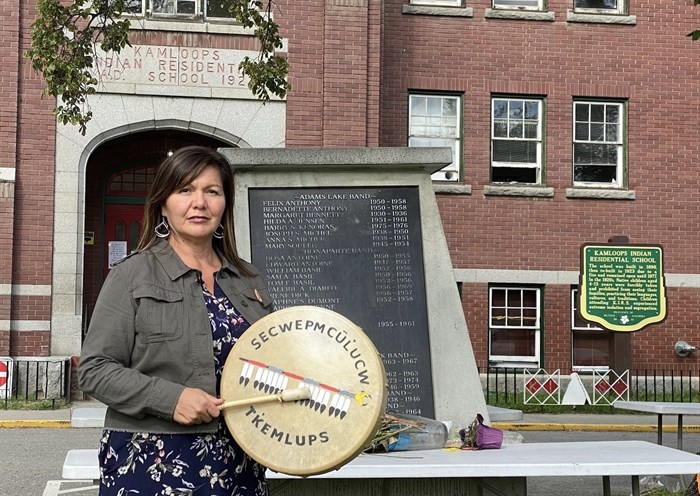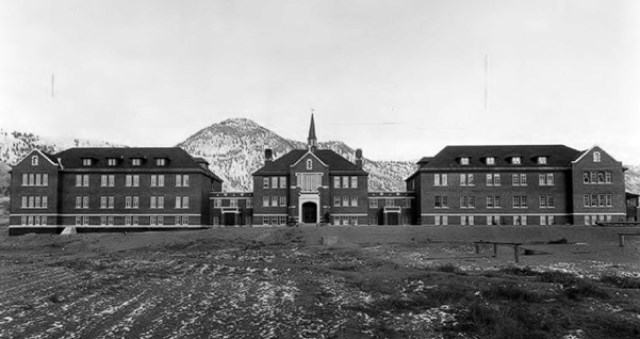
Kukpi7 (Chief) Rosanne Casimir stands in front of a memorial at the Kamloops Indian Residential School.
Image Credit: SUBMITTED/Tk'emlups te Secwepemc
February 16, 2025 - 7:00 AM
Tk'emlups voted to keep the Indian residential school on its land five decades ago in an effort to both reclaim education for Secwepemc children and ensure the memory of the national system isn't forgotten.
That's according to Kukpi7 (Chief) Rosanne Casimir, who, alongside Canada's environment minister, announced the Kamloops Indian Residential School's new designation as a national historic site this week.
Though it has become widely known across the country as the site where Tk'emlups te Secwepemc announced four years ago it had found more than 200 suspected graves, unmarked near the school, the community decided to keep the building as a reminder of the system forced upon Indigenous children back in 1977. It continued as a day school for just one more year.
"Before it closed, Tk'emlups made the decision to preserve several residential school buildings to commemorate and teach about the impacts of residential school," Casimir said. "Even back then it was about looking at repurposing the buildings for reclamation."
Forty-eight years later, the federal government gave the school that was once one of the largest in the entire system the same recognition by making it the fifth Indian residential school deemed a national historic site.
The Indian residential school system in 2015 was deemed an act of "cultural genocide" by the Truth and Reconciliation Commission, but the suspect graves brought a renewed focus on Canada's stained history.
It was first established as the Kamloops Industrial School in 1890, where Indigenous students had an agriculture-focused education and were expected to assimilate to Anglo-Canadian culture.
"It eventually led to the harsh realities and histories we know to this day," Casimir said.
Construction on the red brick structure standing as the centrepiece for the institution started years later in 1923, when students moved in before its completion because of a Christmas Eve fire in 1924 which destroyed the old main building.
Over the years the Catholic-run school had documented food shortages, unsanitary conditions, inadequate clothing and a measles epidemic aggravated by overcrowding, according to UBC records.

A 1930 photograph of the former Kamloops Indian Residential School
Image Credit: Archives Deschâtelets-NDC/Government of Canada
One of the infamous and tragic features of the Indian residential school system was the abuse, including sexual, of students, and Kamloops was no exception. At least one man who once worked at the school in the 1950s and 1960s, Gerald Moran, has been convicted for sexually abusing students.
The 1962 CBC documentary "The Eyes of Children: Christmas at a Residential School" was shot at the same time Moran was working in Kamloops.
"(It) presented an idealized image of a well-run school with happy children. The reality was far different," according to UBC's Indian residential school collection.
After Tk'emlups (then Kamloops Indian Band) took over the school buildings, education remained at its core, but it was focused on Secwepemc "ways of knowing," local culture and history.
It's new name, Chief Louis Centre, honours the former Tk'emlups chief who advocated for local education. Petit Louis, or Clexléxqen, was born in 1828, and Casimir said the continued "reclamation" work honours and takes inspiration from his work.
Though the 2021 ground penetrating radar findings, which spurred a second national reckoning with the Indian residential school system, are front of mind for many at the mention of the Kamloops Indian Residential School, Casimir said that's only one piece in the lengthy road to recognize the site in Canada's historical record.
As for the radar findings and "The Missing," or "Le Estcwicwe´y," the First Nation is still researching and conducting background work in the years after the May 2021 announcement. There have been few public updates on the project since then, but Tk'emlups has committed to repatriating the remains to home communities following consultations with other First Nations.
The school remains under Tk'emlups ownership and while the First Nation is in the process of renovating the building, that work will include preservation of its buildings.
"We're looking at ways to breathe new life into it when it comes to reclamation and revitalization of our language and culture," Casimir said.
The First Nation is still early in planning what that work will include and there are no concepts yet on the table for the eventual construction.
To contact a reporter for this story, email Levi Landry or call 250-819-3723 or email the editor. You can also submit photos, videos or news tips to the newsroom and be entered to win a monthly prize draw.
We welcome your comments and opinions on our stories but play nice. We won't censor or delete comments unless they contain off-topic statements or links, unnecessary vulgarity, false facts, spam or obviously fake profiles. If you have any concerns about what you see in comments, email the editor in the link above. SUBSCRIBE to our awesome newsletter here.
News from © iNFOnews, 2025